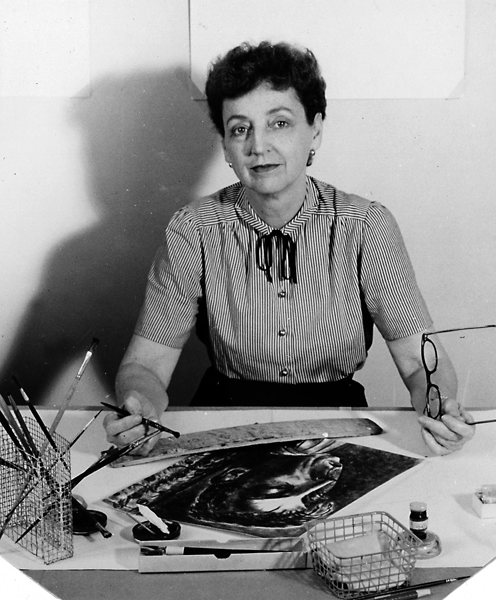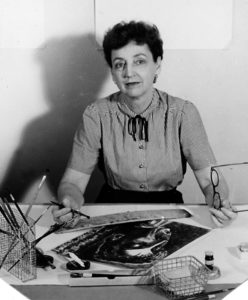Federal Art and Writers Projects
The Federal Art Project and Federal Writers Project helped employ out-of-work artists and writers during the Great Depression.
This entry is 8th Grade level View Full Entry

STATE LIBRARY OF LOUISIANA
Caroline Durieux.
What was the Federal Art Project, and how did it effect the United States and Louisiana?
Established by the New Deal Works Progress Administration (WPA) in 1935, the Federal Art Project (FAP) was an effort to bring art and artists into the everyday lives of Americans while simultaneously extending work relief to artists. Of the four separate New Deal attempts to support the visual arts, the FAP was the largest, most ambitious, and most controversial by far. Curator, art critic, and historian Holger Cahill, who served as director of the project, oversaw the individual state branches, including the Louisiana Art Project (LAP). Between 1935 and 1943, when the program ended, the LAP employed more than fifty artists, primarily in New Orleans. Their collective efforts produced hundreds of original art works allocated among dozens of public institutions throughout Louisiana and across America.
The goals and policies of the LAP reflected the values of Holger Cahill, its director. Interested in blurring the boundary between so-called high and low art—also known as fine and folk art— Cahill wanted to revolutionize the way Americans created, consumed, and understood artistic expression. Cahill worked to establish community art centers across the country. At these centers, artist-workers, laboring on a wage scale, created art that was either allocated to public buildings or displayed in the center’s exhibition gallery. Much of this art was produced in bulk. Nearby classroom facilities offered free instruction in art creation and appreciation. For those unable to attend classes, provisions were also made to send FAP artists out into the community.
Between 1935 and 1943, the FAP worked to make art a mass experience, and none of this occurred without provoking substantial criticism and controversy. Conservative art critics resented Cahill’s abandonment of a high art canon and determination to democratize art. Critics on the left, though generally more supportive, disliked the FAP’s resistance to more experimental, less representational forms. Meanwhile, the FAP’s challenge to entrenched local traditions ruffled feathers in communities across the country, including New Orleans.
From 1939 until its demise in 1943, two women—Caroline Durieux and later Angela Gregory, both artists and former students of artist and educator Ellsworth Woodward, directed the LAP. An enthusiastic supporter of the federal art initiative, lithographer Caroline Durieux expanded the project’s presence within New Orleans and across Louisiana. From classes for children and adults in Baton Rouge to exhibitions in Reserve, Covington, and Boothville, to individual decorations for City Park, the Audubon Zoo, and the Magnolia Housing Project in New Orleans, it seemed that the FAP had finally arrived in Louisiana. Yet none of Durieux’s numerous initiatives pleased federal administrators more than her formal proposal to establish the Orleans Parish Art Center. Featuring two exhibition galleries—one for local displays and another for national FAP tours—as well as classroom facilities and production space for local project artists, the center was intended to be an important cultural resource. But the effort was frustrated. In the spring of 1939, Congress abolished the Federal Theater Project and eliminated the national administrative structure of remaining WPA cultural projects. The affiliated projects, the LAP among them, were returned to the states and forced to secure local sponsorship. For all practical purposes, the reorganization of the WPA limited the LAP’s efforts to the French Quarter, specifically to its local headquarters on Royal Street.
Some LAP art still exists today, and all of it remains deeply related to one of the more momentous periods in the American experience. At one time or another, and in various combinations, several noteworthy Louisiana artists worked for LAP, among them Edward Schoenberger, Clarence Millet, Alice Fowler, Charles Reinike, Herbert Frere, Knute Heldner, Jane Ninas, Hans Manglesdorf, Amelia Geiger, and Lawrence A. Jones. Their work can be seen in collections in places like the National Archives, the Louisiana State Archives, and Louisiana State University.
What was the Federal Writers Project, and how did it affect the United States and Louisiana?
Another one of President Franklin D. Roosevelt’s New Deal programs, the Federal Writers Project (FWP), employed out-of-work writers and editors during the Great Depression. Directed by writer Lyle Saxon, the Louisiana branch of the FWP produced two travel guides—The WPA Guide to New Orleans (1938) and Louisiana: A Guide to the State (1941)—and a folklore collection—Gumbo Ya Ya: A Collection of Louisiana Folk Tales (1945). Unique among the FWP offices, the Louisiana FWP also included an all-Black affiliate, the Dillard History Unit.
Under the supervision of Henry Alsberg, the FWP employed some 6,600 writers, historians, reporters, and editors. Some collected life histories from various sources, including the tales of aging pioneers and formerly enslaved people. Others archived historical records or wrote local histories. But the FWP is best remembered for its extensive array of guidebooks intended to facilitate automobile tourism across the country—one for each state, plus numerous other guides to cities and regions. Known collectively as the American Guide Series, each volume followed a standardized template. The first section presented separate essays on a state’s general background—its history, folkways, architecture, and the like—while the second focused on the state’s cities and towns. The guides concluded with tours designed to take motorists from border to border, north to south, east to west. The first extensive tourist guide to modern America, the series marked a significant cultural milestone.
In 1936 Saxon established the Dillard History Unit, an all-Black LWP affiliate sponsored by Dillard University in New Orleans. The unit operated exactly like its parent organization. Writers researched topics in libraries and archives throughout the city and wrote essays that were edited by Dillard history professor Lawrence Reddick and poet Marcus Christian. When the unit ceased operation in 1942, its cumulative labors had produced “The Negro in Louisiana,” a 1,200-page manuscript detailing the struggles and achievements of Black Louisianans, beginning with the arrival of the first enslaved Africans in 1719. In many ways, the manuscript anticipated professional historical scholarship. It rejected popular stereotypes of slavery and the postwar South, insisting that Black Louisianans had shaped the state’s folk customs, religious practices, cuisine, dancing, speech patterns, dress, and agricultural production in important ways. Chapters emphasized both the harshness of life for enslaved people and their sustained resistance to slaveholders’ power, especially through voodoo rituals.
Throughout its time in operation, LWP writers, Black and white, followed standard production guidelines. They harvested raw material in the field and then refined this information into essays that were checked and rechecked on their way to Washington. Often with the collaborative efforts of National Youth Administration workers, the process began in local courthouses, archives, and libraries, or with interviews of Louisiana residents, often elderly.
At the national level, a conservative backlash in Congress prompted the beginning of the end for the WPA in general and the FWP in particular. In 1939 Congress abolished the Federal Theater Project outright and stripped the remaining national offices of their supervisory capacity. It also forced the affiliated state offices to secure local sponsorship. The entire operation closed in 1943, when the WPA was terminated.
